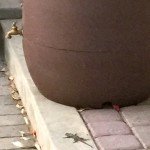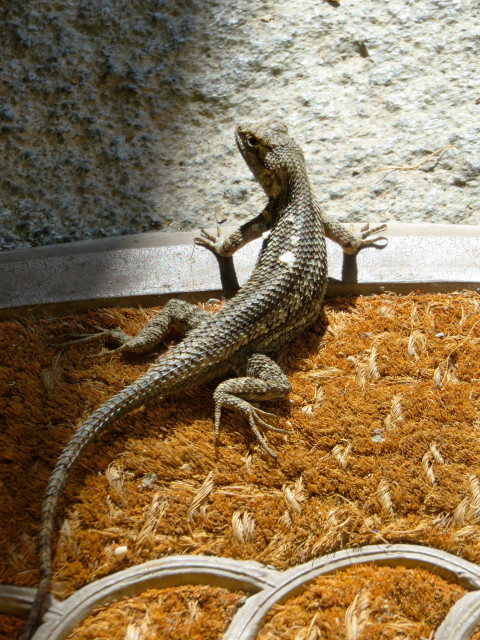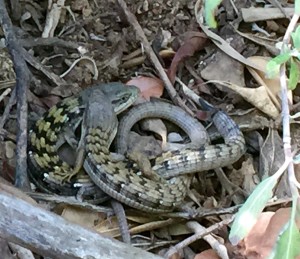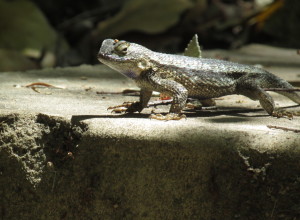It’s springtime in the nature world. We came across two mating lizard couples yesterday while many others are running around like cuckoos trying to get into the game. (… looked up cuckoos and they’re a family of birds that include roadrunners.) The season of love has also struck other animal species. Two of our birdhouses are being prepped by busy Bewick’s wrens. And out in the chaparral and desert, male rattlesnakes are getting territorial, lifting their fronts up to challenge one another.
I thought I would get some answers to things I ponder when observing our yard’s lizards, so I asked Robert Fisher, a biologist with the USGS in San Diego and co-author of A Field Guide to the Reptiles and Amphibians in Coastal Southern California.
Here is what I learned:

Mating Southern Alligator Lizards Lizards mate in springtime, when it warms up and rainfall slows. The Western fence lizard and the longer-tailed Southern Alligator lizard are the most common in our area. Our mating couples were one of each: The Western Fence lizard couple was doing the chase before the mate while the Alligators (see photo) were quite coupled. “A half hour is pretty normal. That’s the last they see each other, except for basking. The female builds a nest in a burrow, and lays eggs in a small hole, and then leaves.” says Fisher. Egg numbers vary from several up to 20 (larger females have larger clutches). They hatch two months later, and are on their own.

Western Fence Lizard doing his pushups for me Those pushups they do are territorial and attract females, but they also flex when no mates seem to be around. “They’re telling you it’s my place, go away,”says Fisher.
- Housecats are their top predator. Other predators include birds such as scrub jays and hawks like cooper hawks. Fisher recommends people keep cats indoors. There’s also a new product out called cat scrunchies, a bright collar for $9.99 that can be put around a cat’s neck to reduce the number of cat-killed lizards, birds and other animals.
- Lizards are saving us billions of healthcare dollars, says Fisher, who explained that in the East where they don’t have lizards, the tick larvae that cause Lyme Disease feed on mice and birds. They become adult ticks, which can then affect people. In the West, we have lizards who are used by the ticks as hosts. Unlike mice and birds, lizards have an antibacterial in them that kills the bacterium that causes Lyme disease,” stopping the disease, says Fisher. (See this article for more info.)
- Lizards love problematic spiders. Lizards eat a variety of insects and they happen to love the taste of brown recluse and black widow spiders.
- Attract them to your yard by “locking up cats, and having rocks for their basking. Cactus or more of a xeriscape yard attract them,” Fisher says. Which explains why our yard –which is about half native, drought tolerant plants — and rich with bugs, is now running with lizards.
One of our favorites is one we call “Painted Lady – see below. She got splattered with white paint during my husband’s painting project a year ago, and now lives under our rain barrel. She still sports some of the paint; who knows, maybe it makes her more attractive.




This week in Redlands I noticed a black lizard had gotten its body stuck head first in a bottom hole of an upside down plastic planter. It took two of us to gently wriggle it out, compressing the tail legs enough to coax its body through head first. That lizard stayed still on our porch much of the day, behind a flat dish of water I put out in the corner, eventually moving to within sight to bask hours in the sun. And I think I saw it this morning on an outside wall
thx, nice story. Fisher didn’t mention them eating ants but that would be great